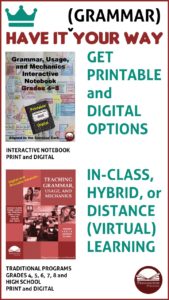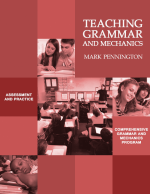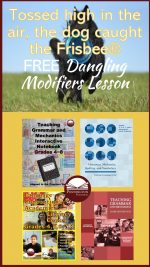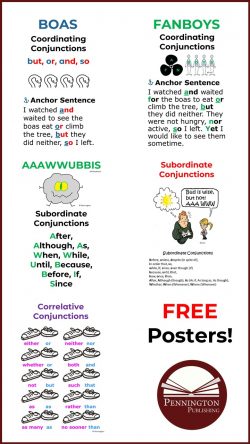
Three Types of Conjunctions
Every teacher knows the wisdom of not telling the whole story, especially with respect to holiday celebrations. But for the purpose of this article, let’s add on conjunctions to the list of teach some of it now and save some for later instruction. Elementary teachers should teach the common conjunctions and secondary teachers should build upon that foundation with less frequently used conjunctions.
Following are brief overviews of the three types of conjunctions: coordinating, subordinate (subordinating), and correlative. The relevant Common Core State Standards are provided and memorable acronyms to help your students identify and apply these grammatical forms. Plus, classroom posters are provided as FREE downloads.
Elementary Instruction: Coordinating Conjunctions
Primary and intermediate teachers face the sometimes daunting task of introducing students to coordinating, subordinating, and correlative conjunctions.
- CCSS.ELA-LITERACY.L.1.1.G
Use frequently occurring conjunctions (e.g., and, but, or, so, because).
- CCSS.ELA-LITERACY.L.2.1.F
Produce, expand, and rearrange complete simple and compound sentences (e.g., The boy watched the movie; The little boy watched the movie; The action movie was watched by the little boy).
- CCSS.ELA-LITERACY.L.3.1.H
Use coordinating and subordinating conjunctions.
- CCSS.ELA-LITERACY.L.4.1.F
Produce complete sentences, recognizing and correcting inappropriate fragments and run-ons.*
- CCSS.ELA-LITERACY.L.4.2.C
Use a comma before a coordinating conjunction in a compound sentence.
- CCSS.ELA-LITERACY.L.5.1.A
Explain the function of conjunctions, prepositions, and interjections in general and their function in particular sentences.
To help students avoid writing in sentence fragments, elementary teachers often counsel their students, “Never start a sentence with but, or, and, or so (the common coordinating conjunctions),” and many teachers would throw in because or like (two subordinating conjunctions) for good measure.
Additionally, most elementary teachers teach the proper use and identification of but, or, and, or so, but not the less frequently used for, nor, and yet. This certainly makes sense.
Elementary teachers may find the BOAS acronym helpful to teach the four common but, or, and, so (boas) coordinating conjunctions:
BOAS (Mark Pennington’s Acronym)

Coordinating Conjunctions
but, or, and, so
Anchor Sentence: I watched and waited to see the boas eat or climb the tree, but they did neither, so I left.
If teaching only the four BOAS seems a bit constricting :), elementary teachers can add in the three additional coordinating conjunctions, usually reserved for middle school.
Secondary Instruction: Coordinating Conjunctions
By middle school, teachers amend the “Never start a sentence with but, or, and, so, because, or like“elementary rule with the addition of “unless you finish the sentence.” Even though the middle school, high school, and college permit and even encourage their developing writers to start sentences with coordinating conjunctions, when appropriate, all would caution their students to use these sentence constructions sparingly.
Plus, secondary teachers will add the three less common and more sophisticated coordinating conjunctions (for, nor, yet) and may use the helpful FANBOYS acronym to teach all seven coordinating conjunctions:

Coordinating Conjunctions
FANBOYS (Creator Unknown)
for, and, nor, but, or, yet, so
Anchor Sentence: I watched and waited for the boas to eat or climb the tree, but they did neither. They were not hungry nor active, so I left. Yet I would like to see them sometime.
For both elementary and secondary teachers, try using this word part trick to help your students understand the meaning of coordinating conjunctions:
The “co” in coordinating means with in Latin. Coordinating conjunctions join with other words, phrase, or clauses of equal importance or emphasis. Example: Both Juan and Stella are good writers.
Elementary Instruction: Subordinate Conjunctions
- CCSS.ELA-LITERACY.L.3.1.H
Use coordinating and subordinating conjunctions.
Elementary teachers may wish to teach their students the 10 most common subordinate conjunctions to introduce dependent clauses (connected nouns and verbs which do not express complete thoughts) at the beginnings and endings of sentences. Examples: After she gave her speech in front of the class, Leslie sat down. Leslie sat down after she gave her speech in front of the class.
Elementary teachers will find the following acronym helpful to teach students to identify and use these subordinate conjunctions:
AAAWWUBBIS (Jeff Anderson’s Acronym)

Subordinate Conjunctions
after, although, as, when, while, until, because, before, if, since
Secondary Instruction: Subordinate Conjunctions
Secondary teachers may wish to teach their students the 29 most common subordinate conjunctions to introduce dependent clauses (connected nouns and verbs which do not express complete thoughts) at the beginnings, in the middle, and the endings of sentences. Examples: After she gave her speech in front of the class, Leslie sat down and heaved a huge sigh of relief. Leslie sat down, after she gave her speech in front of the class, and heaved a huge sigh of relief. Leslie sat down and heaved a huge sigh of relief after she gave her speech in front of the class.
Secondary teachers will find the following acronym helpful to teach students to identify and use these subordinate conjunctions:

Subordinate Conjunctions
Bud is wise, but hot! AAA WWW (Mark Pennington’s Acronym)
Bud is wise, before, unless, despite (in spite of), in order that, so, while, if, since, even though (if)
but hot! because, until, that, how, once, than
AAA after, although (though), as (as if, as long as, as though)
WWW whether, when (whenever), where (wherever)
For both elementary and secondary teachers, try using this word part trick to help your students understand the meaning of subordinating conjunctions:
The “sub” in subordinating means under or below in Latin. Subordinating conjunctions begin adverbial clauses, which are under or below the connecting main (independent clause) in terms of importance or emphasis. Example: Because you listened well this morning, we will work in our groups this afternoon.
Upper Elementary and Secondary Instruction: Correlative Conjunctions (Correlative is pronounced as cor/rél/lƏ/tive.)
Teach the common correlative conjunctions:
both−and; such−that; whether−or; as−as; not−but; neither−nor; no sooner−than; either−or; as many−as; rather−than
For both elementary and secondary teachers, try using this word part trick to help your students understand the meaning of correlative conjunctions:
The “cor” in correlative means to run (correr in Spanish) and “rel” indicates a relationship (in Latin). Coordinating conjunctions are word pairs which run in relationship with each other. The word pairs join parallel words, phrases, or clauses. In grammar, parallel means similar in meaning, structure, and length. Examples: Either chocolate or vanilla is fine. Both girls like chocolate, and they also like vanilla.
*****

Pennington Publishing Grammar Programs
Teaching Grammar, Usage, and Mechanics (Grades 4, 5, 6, 7, 8, and High School) are full-year, traditional, grade-level grammar, usage, and mechanics programs with plenty of remedial practice to help students catch up while they keep up with grade-level standards. Twice-per-week, 30-minute, no prep lessons in print or interactive Google slides with a fun secret agent theme. Simple sentence diagrams, mentor texts, video lessons, sentence dictations. Plenty of practice in the writing context. Includes biweekly tests and a final exam.
Grammar, Usage, and Mechanics Interactive Notebook (Grades 4‒8) is a full-year, no prep interactive notebook without all the mess. Twice-per-week, 30-minute, no prep grammar, usage, and mechanics lessons, formatted in Cornell Notes with cartoon response, writing application, 3D graphic organizers (easy cut and paste foldables), and great resource links. No need to create a teacher INB for student make-up work—it’s done for you! Plus, get remedial worksheets, biweekly tests, and a final exam.
Syntax in Reading and Writing is a function-based, sentence level syntax program, designed to build reading comprehension and increase writing sophistication. The 18 parts of speech, phrases, and clauses lessons are each leveled from basic (elementary) to advanced (middle and high school) and feature 5 lesson components (10–15 minutes each): 1. Learn It! 2. Identify It! 3. Explain It! (analysis of challenging sentences) 4. Revise It! (kernel sentences, sentence expansion, syntactic manipulation) 5. Create It! (Short writing application with the syntactic focus in different genre).
Get the Diagnostic Grammar, Usage, and Mechanics Assessments, Matrix, and Final Exam FREE Resource:

Want the poster size 11 x 17 Conjunction Posters you see in this article for your classroom? I’ll send the PDFs right away to your email.
Get the Conjunction Posters FREE Resource:

Grammar/Mechanics, Literacy Centers, Study Skills, Writing
3 types of conjunctions, AAAWWUBBIS, BOAS, complex sentences, compound sentences, conjunction junction, conjunction types, conjunctions, coordinating conjunctions, correlative conjunctions, FANBOYS, grammar interactive notebook, Grammar Literacy Center, grammar programs, Language Conventions, Mark Pennington, parts of speech, schoolhouse rock, subordinate conjunctions, subordinating conjunctions, Teaching Grammar and Mechanics
 Teaching Grammar, Usage, and Mechanics Grades 4, 5, 6, 7, and 8 are full-year programs with plenty of remedial practice to
Teaching Grammar, Usage, and Mechanics Grades 4, 5, 6, 7, and 8 are full-year programs with plenty of remedial practice to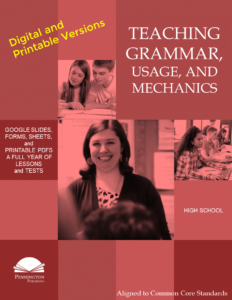

![]()


